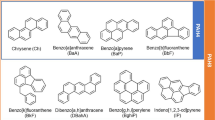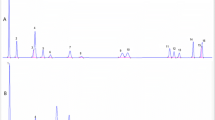Abstract
Lebanon has witnessed elevated levels of pollution over the last few years due to increased waste incineration, emissions from vehicles and electricity generators, and mass demonstrations involving the burning of tires. The resultant generation of polycyclic aromatic hydrocarbons (PAHs) from the incomplete combustion of organic materials present in these sources may contaminate various foods including olive oil. Lebanon has a sizeable olive oil industry that is a main pillar of its agricultural sector. In this study, we investigated the occurrence of 16 semi-volatile lipophilic organic pollutants in 25 bottled olive oil brands, marketed in Lebanon, using a solid phase extraction (SPE) method followed by gas chromatography mass spectrometry (GC–MS). PAHs were detected in 60% of brands (41% of samples) where 12% of brands contained traces of probably carcinogenic (Class 2A) compounds and 56% of brands contained traces of possibly carcinogenic (Class 2B) compounds. One brand revealed levels of benzo[a]pyrene of 9.45 μg/kg and 11.9 μg/kg in batches collected over two production dates which are higher than the limit set by the European Commission for benzo[a]pyrene in food (2 μg/kg). The same batches contained a total of 19.3 μg/kg and 26.7 μg/kg of the four PAHs: benzo[a]pyrene, benz[a]anthracene, benzo[b]fluoranthene, and chrysene which also exceeded the limit set by the EC for the combination of these four PAHs in olive oil (10 μg/kg). This study is the first-of-its-kind in Lebanon and emphasizes the need to perform adequate cleanup steps in the manufacturing process in order to reduce the content of carcinogenic PAHs in olive oil.
Similar content being viewed by others
References
Seabra RM, Andrade PB, Valentão P, Faria M, Paice AG, Oliveira MBPP (2010) Phenolic profiles of portuguese olives: cultivar and geographics. Chap 20. In: Preedy VR, Watson DP (eds) Olives and olive oil in health and disease prevention. Academic Press, San Diego, pp 177–186
Verallo-Rowell VM, Dillague KM, Syah-Tjundawan BS (2008) Novel antibacterial and emollient effects of coconut and virgin olive oils in adult atopic dermatitis. Dermatitis 19:308–315
Investment Development Authority of Lebanon I (2017) Olive oil industry in Lebanon: Fact Sheet
Lebanese Ministry of Agriculture (2012) Lebanese republic ministry of agriculture overview of the Lebanese Olive Sector. In: 100th session of the International Olive Council of Members and Committee Meetings. Madrid, Spain
Fares Y (2008) Integrated waste management for the olive oil pressing industries in Lebanon, Syria and Jordan: impact of olive oil pressing techniques on olive oil quality. UNDP, MoE Lebanon. http://olivepress.moe.gov.lb/oopi/Library/Documents/pdf/question%203f%20website.pdf. Accessed 12 Dec 2018
Cirla PE, Martinotti I, Buratti M, Fustinoni S, Campo L, Zito E, Prandi E, Longhi O, Cavallo D, Foà V (2007) Assessment of exposure to polycyclic aromatic hydrocarbons (PAH) in Italian asphalt workers. J Occup Environ Hyg 4:87–99
Mumtaz MM, George JD, Gold KW, Cibulas W, Derosa CT (1996) ATSDR evaluation of health effects of chemicals. IV. Polycyclic aromatic hydrocarbons (PAHs): understanding a complex problem. Toxicol Ind Health 12:742–971
Phillips DH (1999) Polycyclic aromatic hydrocarbons in the diet. Mutat Res 443:139–147
Dennis MJ, Massey RC, Cripps G, Venn I, Lee G (1991) Factors affecting the polycyclic aromatic hydrocarbon content of cereals, fats and other food products. Food Addit Contam 8:517–530
Lee S-Y, Lee J-Y, Shin H-S (2015) Evaluation of chemical analysis method and determination of polycyclic aromatic hydrocarbons content from seafood and dairy products. Toxicol Res 31:265–271
Rodríguez-Acuña R, del Pérez-Camino M, del Certand CA, Moreda CA (2008) Sources of contamination by polycyclic aromatic hydrocarbons in Spanish virgin olive oils. Food Addit Contam Part A 25:115–122
Fromberg A, Hojgard A, Duedahl-Olesen L (2007) Analysis of polycyclic aromatic hydrocarbons in vegetable oils combining gel permeation chromatography with solid-phase extraction clean-up. Food Addit Contam 24:758–767
Pupin AM, Cecilia M, Toledo F (1996) Benzo(a)pyrene in olive oils on the Brazilian market. Food Chem 55:185–188
Tfouni SAV, Padovani GR, Reis RM, Furlani RPZ, Camargo MCR (2014) Incidence of polycyclic aromatic hydrocarbons in vegetable oil blends. Food Control 46:539–543
Purcaro G, Moret S, Conte LS (2008) Rapid SPE-HPLC determination of the 16 European priority polycyclic aromatic hydrocarbons in olive oils. J Sep Sci 31:3936–3944
Wu S, Yu W (2012) Liquid-liquid extraction of polycyclic aromatic hydrocarbons in four different edible oils from China. Food Chem 134:597–601
Teixeira VH, Casal S, Oliveira MBPP (2007) PAHs content in sunflower, soybean and virgin olive oils: evaluation in commercial samples and during refining process. Food Chem 104:106–112
Costopoulou D, Vassiliadou I, Chrysafidis D, Bergele K, Tzavara E, Tzamtzis V, Leondiadis L (2010) Determination of PCDD/F, dioxin-like PCB and PAH levels in olive and olive oil samples from areas affected by the fires in summer 2007 in Greece. Chemosphere 79:285–291
Ergönül PG, Sánchez S (2013) Evaluation of polycyclic aromatic hydrocarbons content in different types of olive and olive pomace oils produced in Turkey and Spain. Eur J Lipid Sci Technol 115:1078–1084
Abdulkadar AHW, Kunhi AAM, Jassim AJ, Abdulla AA (2003) Determination of benzo(a)pyrene by GC/MS/MS in retail olive oil samples available in Qatar. Food Addit Contam 20:1164–1169
Krajian H, Odeh A (2014) Polycyclic aromatic hydrocarbons in Syrian olive oils and their likely daily intakes. Toxicol Environ Chem 96:342–352
Alomirah H, Al-Zenki S, Husain A, Sawaya W, Ahmed N, Gevao B, Kannan K (2010) Benzo[a]pyrene and total polycyclic aromatic hydrocarbons (PAHs) levels in vegetable oils and fats do not reflect the occurrence of the eight genotoxic PAHs. Food Addit Contam Part A 27:869–878
Chung SWC, Lau JSY (2015) Analytical Methods friendly single extraction and cleanup method for polycyclic aromatic hydrocarbons in edible oils and fats. Anal Methods 7:7631–7638
Guideline ICH Harmonized Tripartite. (1996) Guideline for good clinical practice E6(R1). In: International conference on harmonization of technical requirements for registration of pharmaceuticals for human use
Menichini E, Bocca A, Merli F, Ianni D, Monfredini F (1991) Polycyclic aromatic hydrocarbons in olive oils on the Italian market. Food Addit Contam 8:363–369
Zelinkova Z, Wenzl T (2015) The occurrence of 16 EPA PAHs in food—a review. Polycycl Aromat Compd 35:248–284
EFSA (European Food Safety Authority) (2008) Polycyclic aromatic hydrocarbons in food [1]—scientific opinion of the panel on contaminants in the food chain. EFSA J 724:1–114
Wilson S, Jones K (1993) Bioremediation of soil contaminated with polynuclear aromatic hydrocarbons (PAHs): a review. Environ Pollut 81:229–249
Acknowledgements
The authors gratefully acknowledge the American University of Science and Technology (AUST) research fund.
Author information
Authors and Affiliations
Corresponding author
Ethics declarations
Conflict of interest
The authors have no conflict of interest to declare.
Rights and permissions
About this article
Cite this article
Elaridi, J., Fakhro, M., Yamani, O. et al. GC–MS analysis of polycyclic aromatic hydrocarbons in bottled olive oil marketed in Lebanon. Toxicol Res. 36, 211–220 (2020). https://doi.org/10.1007/s43188-019-00015-3
Received:
Revised:
Accepted:
Published:
Issue Date:
DOI: https://doi.org/10.1007/s43188-019-00015-3




